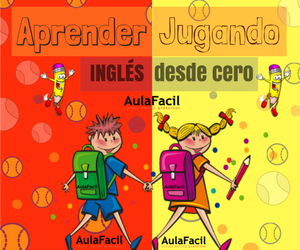On
“On” puede funcionar como preposición, adverbio, adjetivo o nombre. A continuación analizamos su uso como preposición.
1.- Preposición de lugar:
1.1.- Sobre, encima (en contacto con una superficie):
On the wall
On the ceiling
On the cover
On the floor
On the carpet
On the table
On the chair
On the trouser
…
Ejemplos:
I put the letter on the table
I left the suitcase on the floor
There is a fly on the ceiling
My glasses are on the desk
The cat sleeps on my bed
The mirror is on the wall
This morning there was ice on the road
Could you write your phone number on that paper?
My office is on the first floor
Look at that stain on your trouser!
The solar panels are on the roof
“On” indica posición pero también movimiento hacia una superficie:
I threw the coat on the chair
My son jumps on the trampoline
My car keys fell on the floor
I dropped my jacket on the bed
1.2.- Indica proximidad, a lo largo de (hace referencia a lugares con forma lineal):
On streets
On avenue
On the beach
…
Ejemplos:
I bought a house on the river
Barcelona is on the Mediterranean coast
You can find that bookshop on Oxford street
1.3.- Otros usos
Con planetas: On Earth, on Jupiter, on Saturn
Con otros lugares: On a farm, on the field…
1.4.- Otras expresiones:
On the left
On the right
On the way (en el camino)
Ejemplos:
The cathedral is on the left
2.- Preposición de tiempo
Con días de la semana:
On Monday, On Saturday…
Con fechas:
On 28th October
On April 15th 1964
Con fiestas / días especiales:
On Easter Sunday
On Christmas day
On New Year’s Eve
On Valentine’s day
On your birthday
Ejemplos:
I was born on the 15th of November in 2002
I will go to London on Wednesday
We have a family dinner on Christmas day
3.- Con medios de transporte:
Cuando hablamos del medio de transporte empleado utilizamos la preposición “by”
I went by train / by car / by plane… (Fui en tren / en coche / en avión )
Pero: on foot (andando)
Cuando hablamos de un vehículo concreto entonces se utiliza la preposición “in / on” (dependiendo del tipo de transporte)
IN: cuando vamos sentado
I went in a car / in a taxi / in a truck / in a helicopter…
ON: cuando nos podemos levantar y movernos
I went on a ship / on a plane / on a train / on a bus…
Atención: I was in a ship (no hago referencia al medio de transporte utilizado sino al lugar donde me encontraba)
ON: también cuando vamos sentado o de pie en la parte de arriba del vehículo
I went on a bicycle / on a motorcycle / on a surfboard / on skis / on a skateboard / on foot / on a horse…
Veamos algunos ejemplos:
I went to London by plane; I flew on a very old plane
We went to the theatre by car, in my brother’s car
Edward went to America by sea; he went on a luxury cruise
He enjoys on a jet ski
4.- Otros significados
4.1.- Comunicación a través de un dispositivo: on the radio, on the computer, on TV, on the phone…
The Wimbledon final was broadcasted on TV
The final math will be on TV next Sunday
4.2.- Relativo a
The Government has introduced a new tax on petrol
The lawyer asked my opinion on that matter
4.3.- Estado, situación en la que se encuentra alguien / algo
That car is on fire
That store has many items on sale
Diferencias
5.1.- Preposición de lugar: On vs Onto
“On” indica posición sobre una superficie o movimiento hacía una superficie, mientras que “Onto” sólo indica movimiento hacia una superficie.
Por tanto, ambas preposiciones son válidas para indicar movimiento si bien “Onto” enfatiza más esta acción.
My jacket is on the bed (NO: My jacket is onto the bed)
I threw my jacket on / onto the bed
5.2.- Dirección exacta (con indicación del número de la calle)
Con una dirección exacta se utiliza la preposición “At”:
My office is located at 725 Oxford Street
No es correcto: My office is located on 725 Oxford Street
Otros ejemplos:
My friend lives at 143 7th Avenue
The restaurant is at 243 Madison Street
Pero si la dirección no es exacta (por ejemplo, no incluye el número) no se utiliza “At”:
My office is on Oxford Street
No es correcto: My office is at Oxford Street
5.3.- On the street / In the street
In the street: por donde circulan los coches
On the street: a lo largo de la calle, a ambos lados
Ejemplos:
You shouldn’t play football in the street
There is an Indian restaurant on that street
The swans walk in the street
5.4.- Momentos del día
Con momento del día se utilizan las preposiciones:
in the morning, in the afternoon, in the evening, in the middle of the day
Pero cuando concretamos el día utilizamos “On”:
On Monday morning
On Tuesday afternoon
On Thursday evening
On Saturday night
5.5.- On time / In time
On time: momento exacto, ni antes ni después
In time: puede que antes o después, pero con tiempo suficiente para realizar la actividad prevista: por ejemplo, llego tarde a la estación pero como el tren viene con retraso no lo pierdo:
I arrived at the station in time to take the train
Otros ejemplos:
Our plane landed on time (exactamente a la hora prevista)
My brother arrived to the cinema on time to see the movie (a la hora programada para la película)
My brother arrived to the cinema in time to see the movie (no pudo ver los anuncios previos pero si la película)
5.6.- Expresiones de tiempo introducidas por “every / last / next / this / yesterday / tomorrow…”
No se utilizan las preposiciones de tiempo “at / on / in” delante de “every / last / next / this / yesterday / tomorrow…”:
What do you do on Friday?
What do you do next Friday?
I watched that program on Tuesday night
I watched that program last Tuesday night
I play tennis on Saturday
I play tennis every Saturday
5.7.- At the weekend / On the weekend
En inglés británico se utiliza “At the weekend” mientras que en inglés americano se utiliza “On the weekend”




